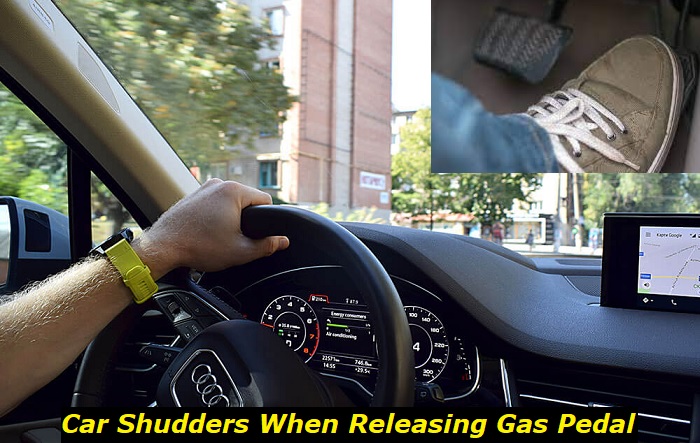If your car shudders when taking your foot off the accelerator, it could be caused by a variety of different reasons. Usually, it is engine-related problems like misfires or vacuum leaks. The issue could also lie in your transmission as torque converter problems or even low transmission fluid can also cause the same issue. Other reasons include worn U-joints or CV joints.
Engine vibrations highlights
- Level of importance:Low
- Commonreasons:Misfiring, engine damage, transmission problems, drive shafts problems
- DIY inspection:Extremely complicated
- DIY repair:Impossible
- Price for repair:$500 - $1,000
- Can you drive?In most cases, yes
- Ways to fix:Only professional repair ispossible,in most cases

Engine Misfires
This is one of the most common reasons why your car shudders when taking your foot off the accelerator. Misfires happen when your engine fails to ignite the fuel mixture inside one of its cylinders. In a smoothly functioning engine, each cylinder will ignite the fuel-air mixture inside it in a precisely timed sequence. When this sequence fails, it causes a noticeable hiccup in your engine's performance which is called a misfire.
When a cylinder in your engine misfires, it fails to contribute its share to power the engine's rotations. This momentary drop in power causes a sudden drop in RPM which causes the shuddering effect when taking the foot off the pedal. The same uneven power delivery can cause vibrations can generate vibrations throughout the vehicle which is especially noticeable in the driver's seat.
1) Causes
As mentioned, misfires are caused when the engine fails to combust the fuel-air mixture. More often than not, this is due to foul spark plugs. The plugs are in charge of creating the spark that ignites the mixture. Without this spark, your engine will misfire. When spark plugs become dirty, worn off, or corroded, they tend to fail. Similarly, if the power source of the spark plug, which is the ignition coil, fails, it will also result in misfires.
A faulty fuel injector can also cause your engine to misfire. Fuel injectors spray a precise amount of fuel at precise intervals, which is then burnt off in your ignition chamber. If the fuel injector is clogged or damaged, it will fail to deliver an adequate amount of fuel which will also lead to misfires.
A combustion engine relies on both fuel and air. And in the same manner that a faulty fuel injector causes misfires, a vacuum leak can also cause misfires. Vacuum leaks occur when unintended openings or cracks develop in the vacuum system. Through these cracks, unintended air enters the combustion chamber. This excess air disrupts the finely tuned air to fuel balance, which can cause misfires.
2) Solution
The solution will depend on the exact cause of the misfire. You could dive further into the problem with a diagnostic scan. Reading the error code can pinpoint the exact problem that is causing your car to shudder when taking the foot off the accelerator.
If your spark plugs are fouled, it is a pretty easy fix. All you have to do is get your spark plugs replaced. They are quite inexpensive and easy to replace. In some cases, you might be able to squeeze a few more miles off your existing spark plugs by simply cleaning them. While you are at it, also make sure to check your ignition coils, wires, and other components for damage and malfunctions.
If the misfires are caused by a problem with the fuel delivery, the repairs are a bit more complicated. A clogged fuel injector can be cleaned, but it's not a simple process. You are going to need a fuel injector cleaner. Disconnect the fuel pump and follow the instructions on your fuel injector cleaning kit to get your injectors unclogged. Another option is to get your fuel injectors replaced.
If timing problems are suspected, adjustments may be needed to ensure proper synchronization.
In case of a vacuum leak, look for a hissing or whistling sound that'll allow you to locate the vacuum leak. Inspect vacuum hoses, connectors, gaskets, and intake manifold components for visible cracks, splits, or loose connections. If the leak was from the hoses or connectors, you might be able to manage to repair it yourself. If it were the gasket or the intake manifold, you might have to seek a professional mechanic to proceed with the repairs.
Transmission Problems
1) Causes
Sometimes even the simplest problems can be the reason why your car shudders when you take your foot off the accelerator. One such problem is low or dirty transmission fluid. The primary function of the transmission fluid is to lubricate and allow the gears to shift smoothly. It also helps keep the transmission cool.
But how does low or dirty transmission fluid translate to the shuddering effect when taking the foot off the accelerator? Without adequate transmission fluid to lubricate your gears and keep your transmission cool, you will experience erratic and harsh shifting. This would lead to a shuddering effect as you take the foot off the pedal and the gears change.
But low transmission fluid isn't the only problem that might result in your car shuddering when you take your foot off the accelerator. Another transmission woe that could cause the same effect is the torque converter. In automatic transmissions, the torque converter plays a pivotal role as it serves as the hydraulic coupling between the engine and transmission. It allows power to transfer smoothly from your engine to your transmission and ultimately to your wheels.
The shuddering effect that is caused by the torque converter can be narrowed down to a specific feature within your car known as lock-up. Lock-up is a mechanism that is implemented in modern cars to improve fuel efficiency. When this lock-up feature doesn't engage or disengage properly, it could lead to a shuddering when taking the foot off the accelerator.
2) Solution
If you are having problems with your torque converter, chances are you are going to have to get it replaced. For this, you'd have to disassemble the transmission, access the torque converter, and get it replaced. There is a chance that you might be able to salvage your torque converter by repairing it, so it is recommended to seek professional help to get your torque converter issues sorted out.
Low or dirty transmission fluid is a much easier problem to solve. If you are running low on transmission fluid, you can simply top it off. Manufacturers recommend that you get your transmission fluid replaced between 30,000 to 60,000 miles. Adhering to your manufacturer's guidelines would save you from a whole lot of transmission-related problems.
Drivetrain Problems
It's not only the engine and transmission that can lead to a shuddering effect when taking the foot off the gas. Even wear on your drivetrain components like U-joints, CV joints, and differential can lead to a similar shuddering effect.
1) Causes
U-joints are typically seen in rear-wheel drive vehicles and four-wheel drive vehicles. They are flexible couplings that allow the driveshaft to transmit power to the wheels at varying angles. CV joints are quite similar as well as they allow the front axle to transmit power while accommodating different steering angles. And these CV joints are commonly seen in front-wheel drive vehicles and all-wheel drive vehicles. By allowing flexibility and smooth power transfer, these joints contribute to stable and controlled vehicle movement.
Just like any other component in your car, these joints deteriorate with time. And as these U-joints and CV joints deteriorate they can develop play and looseness. This can develop excessive vibrations along with a shuddering effect when accelerating and decelerating. Along with the shuddering, you'll also notice clicking or clunking noises when your joints are worn off.
Another drivetrain component that can be behind why your car shudders when taking your foot off the accelerator is the differential. Unlike U-joints are CV joints, differentials are seen in every vehicle. They allow wheels on the same axle to turn at different speeds. This is necessary when vehicles turn corners because the outer wheel travels a longer distance than the inner wheel.
When your differential isn't adequately lubricated, the unit overheats and wears off prematurely. This can also cause a shuddering sensation when taking your foot off the gas.
2) Solution
The best way to diagnose your CV joint or U-joint is through a visual inspection. Accessing these joints is the hardest as you are going to have to remove the driveshaft from your vehicle and disconnect the transmission. And if your joints show signs of wear or damage, get them replaced.
When differential issues arise, the specific repair options depend on the nature and severity of the problem. If you tackle the issue at its early stages, your differential might not have suffered major damages and you should be able to get it repaired. Start by draining your old fluid and top it up with fresh manufacturer-recommended lubricant. In case the gears are damaged, you are going to have to get them replaced as well.
If the differential housing or components are severely damaged or worn beyond repair, replacement is usually the safest and most effective option. If you've done upgrades to your engine or swapped out your tires to larger ones, your stock differential might not be able to support them. If this were the case, you'd have to get your differential upgraded with an aftermarket alternative.
About the authors
The CarAraC research team is composed of seasoned auto mechanics and automotive industry professionals, including individuals with advanced degrees and certifications in their field. Our team members boast prestigious credentials, reflecting their extensive knowledge and skills. These qualifications include: IMI: Institute of the Motor Industry, ASE-Certified Master Automobile Technicians; Coventry University, Graduate of MA in Automotive Journalism; Politecnico di Torino, Italy, MS Automotive Engineering; Ss. Cyril and Methodius University in Skopje, Mechanical University in Skopje; TOC Automotive College; DHA Suffa University, Department of Mechanical Engineering






Add comment